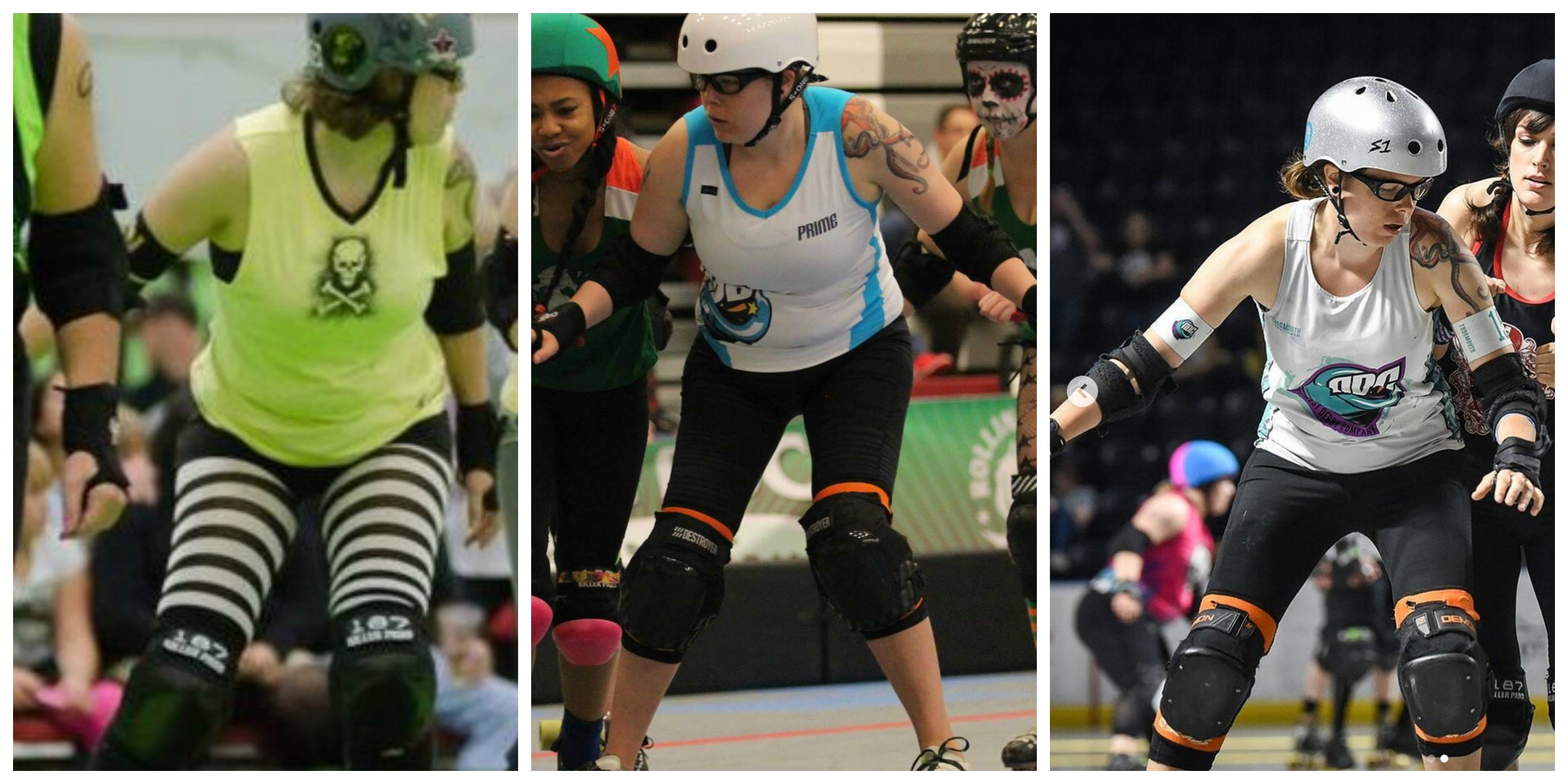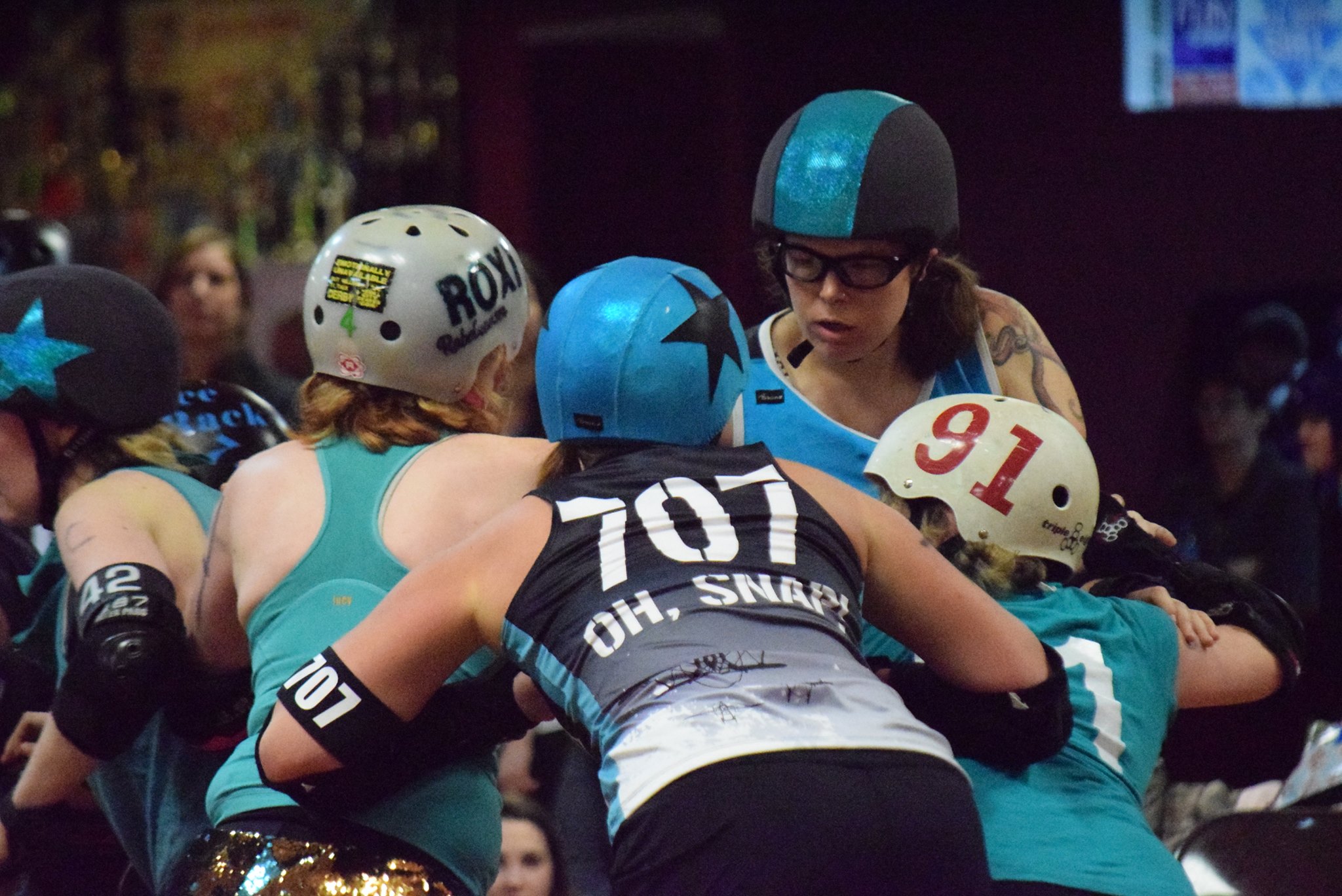
A few nights ago, I looked into the gleaming eager eyes of the skaters in our newest cycle. These are the ones that have been on their skates for only a few months and are still experiencing the absolute first (and potentially deepest) flush of their love with roller derby. They love everything about the sport and yet the thought of what they have to eventually do on their skates terrifies.
I remember being there. I remember that struggle. And I feel simultaneously lucky and sad that the pain has dulled over time. Similar to the way the pain of labor or stubbing your toe fades.
I looked into their excited, happy faces and I told them the truth:
You are going to have to train your body to do something it’s not supposed to do.
Humans, by and large, aren’t designed to constantly turn left after all. We’re bipedal and designed for forward movement. Pursuit predation. Pacing things over long distances by walking. Forward. With even resistance on both legs.
Roller derby isn’t the only sport in which we’re fighting against the very mechanics of our human body. Think about how much torque must occur to the shoulder of a major league pitcher, after all. But it does seem to be one of the few sports in which we completely ignore the fact that we’re working against nature.
Your hips are not built to constantly twist to the left. Or push out and back in a skating motion. Or leap into the air while other humans throw themselves at you. All while wearing roller skates.
But not being built for something doesn’t mean that you can’t do it.
As evidenced by the thousands of skaters that have gone through the struggle of strapping wheels to their feet and sacrificing themselves to the derby goddess.
There’s really one, big, HUGE thing that you can do that will help tremendously.
START TRAINING OFF-SKATES.
And, within that, there are some places that you should focus.
1) Get mobile.
Don’t cut out warming up before practice or stretching after it. And more specifically, take at least 20-30 minutes once a week to specifically focus on maintaining (or regaining) mobility in your joints. Every single one of your joints take a beating in roller derby so you’re doing yourself a favor to make sure that your ankles, knees, hips, and shoulders all remain in working order with their entire range of motion.
2) Get stable.
Work as much single limb movements into your training as you can. These will serve the dual purpose of helping you counteract some of the imbalances that roller derby can cause. But getting stable also means making sure you work a variety of muscles so that your body can keep working the way that it always has. You really DON’T want one leg that much stronger than the other.
3) Get strong.
Challenge yourself to do more. I’m obviously a huge fan of strength training and think that any athlete NOT doing it is doing themselves a massive disservice. The more weight you can physically move off your skates, the more you can move on your skates. Whether you’re a blocker clearing space for your jammer or a jammer trying to push a sticky tripod. Strong muscles also help reduce the risk of injury and make general life tasks (carrying grocery bags, anyone?) easier. Plus, picking yourself off the ground is no sweat when you can pick up something bigger and heavier than that.
Challenge Yourself At Your Level
It’s easy to get stuck on other things.
The number of people that tell me they want to jump the apex or be more powerful or boost their agility are legion. But a lot of those skills are EARNED by doing the basics first. Becoming mobile, stable, and strong will open the doors to being jumpy, powerful, and jukey.
You’ll get there. But you have to start where you are first.
If you’re new to training, there are a few basic things you can focus on within your off-skates training that will help you meet the “3 Simple Things” above. As well as build your foundation to do things that aren’t so simple.
In terms of mobility…
- Fit in exercises that focus on specific ranges of motion in your joints during your warm-up.
- Pair mobility exercises with weighted exercises. (i.e. squats followed by ankle mobility)
- Set aside an active recovery day to work on mobility specific to what you need for 30 minutes at once.
- Get a movement assessment to help you determine where to focus your energy.
There are common areas of immobility that skaters have, but this is not the time to guess. Look up movement assessments for athletes online (or, better yet, go to a Physical Therapist) and identify where you need work. It really does make a huge difference. Even if you can’t tell as you do it.
In terms of stability…
- Do anterior core work.
- Spend time isolating and working on all the muscles of your hips.
- Avoid doing extra reps or lifting more weight on the leg that is already stronger.
- Pay attention to the placement of your feet and knees during exercises and everyday movements.
Are you knock-kneed? Or pigeon-toed? Those are things you can work on and be aware of even when you AREN’T training. But they are most definitely things you should be aware of when you are training. Spending time looking at your movement assessment (oh, look, that thing again!) and strengthening your lagging muscles will pay huge dividends.
In terms of strength…
- Lift in sets of 3-4 and reps of 8-10. To start.
- Pull twice as often as you push. At least.
- Don’t be afraid to start light (especially as you work on mobility and stability) and increase weight later.
- “Heavy” is relative.
Your heavy isn’t my heavy and that’s fine. There are people out there warming up with what I think is heavy. The point is that your strength will grow as you challenge yourself with what’s heavy for you.
If you’re not training yet, what are you waiting for? There’s no easier way to improve your on-skate skills.
Want more?
If you’re new to training and/or need to kick your minimum skills in the mouth, check out the Takedown the 27/5 Program. It focuses on the 3 Simple Things listed above as well as:
- Gets your brain and muscles talking to each other, so that your muscles can fire more effectively
- Helps build body awareness, so that your body can do MORE things while thinking LESS
- Creates a foundation of strength that can take help move you into more intense training programs later
- Works on movement patterns that will transfer directly to your skates
- Reduces the likelihood of injuries
THIS WILL HELP. SIGN UP — for free — HERE.
Time to put some work in off-skates, too!

